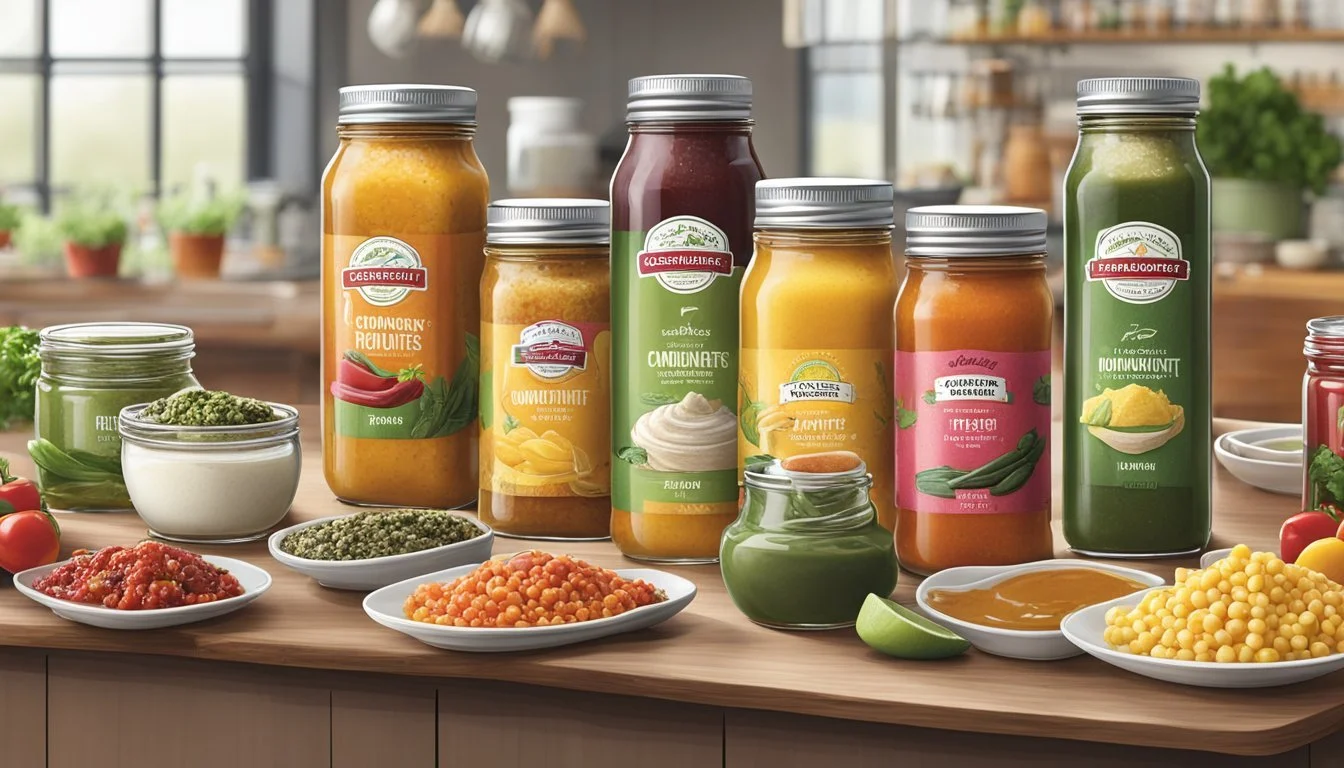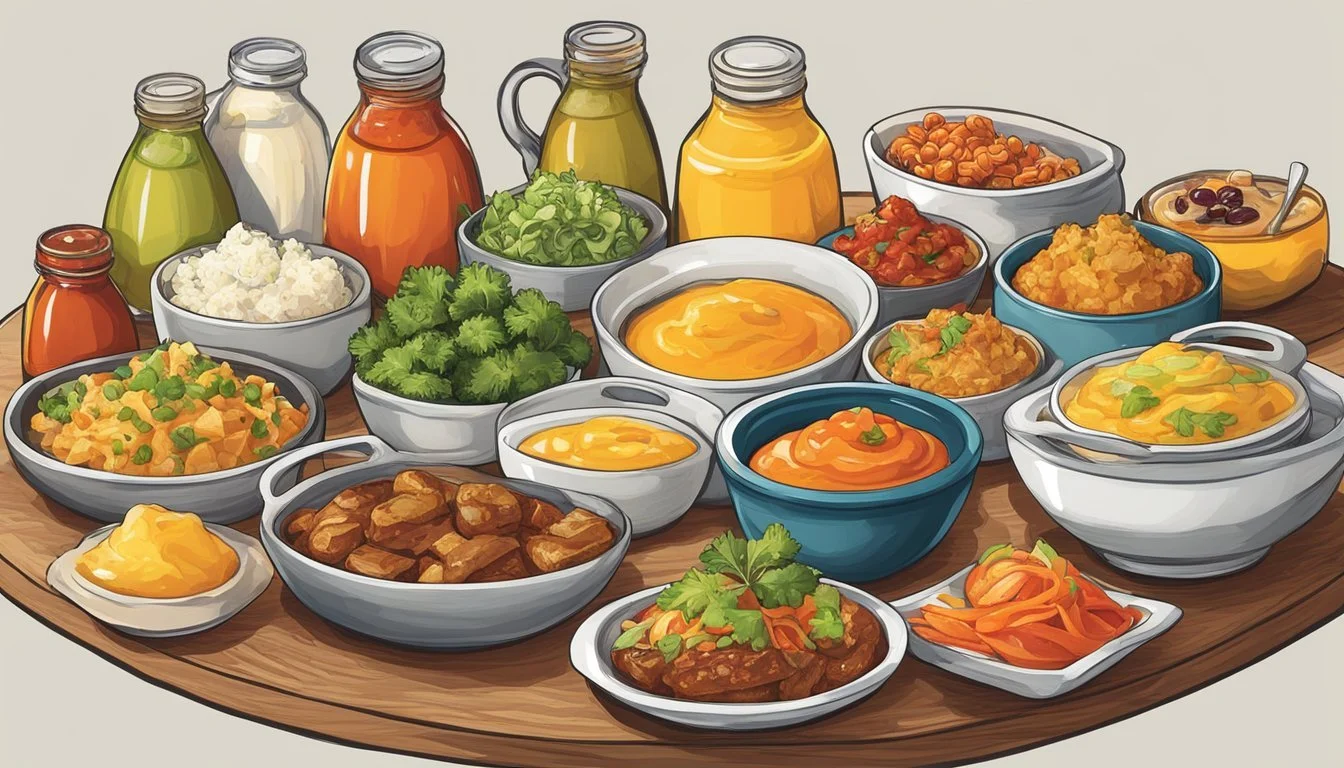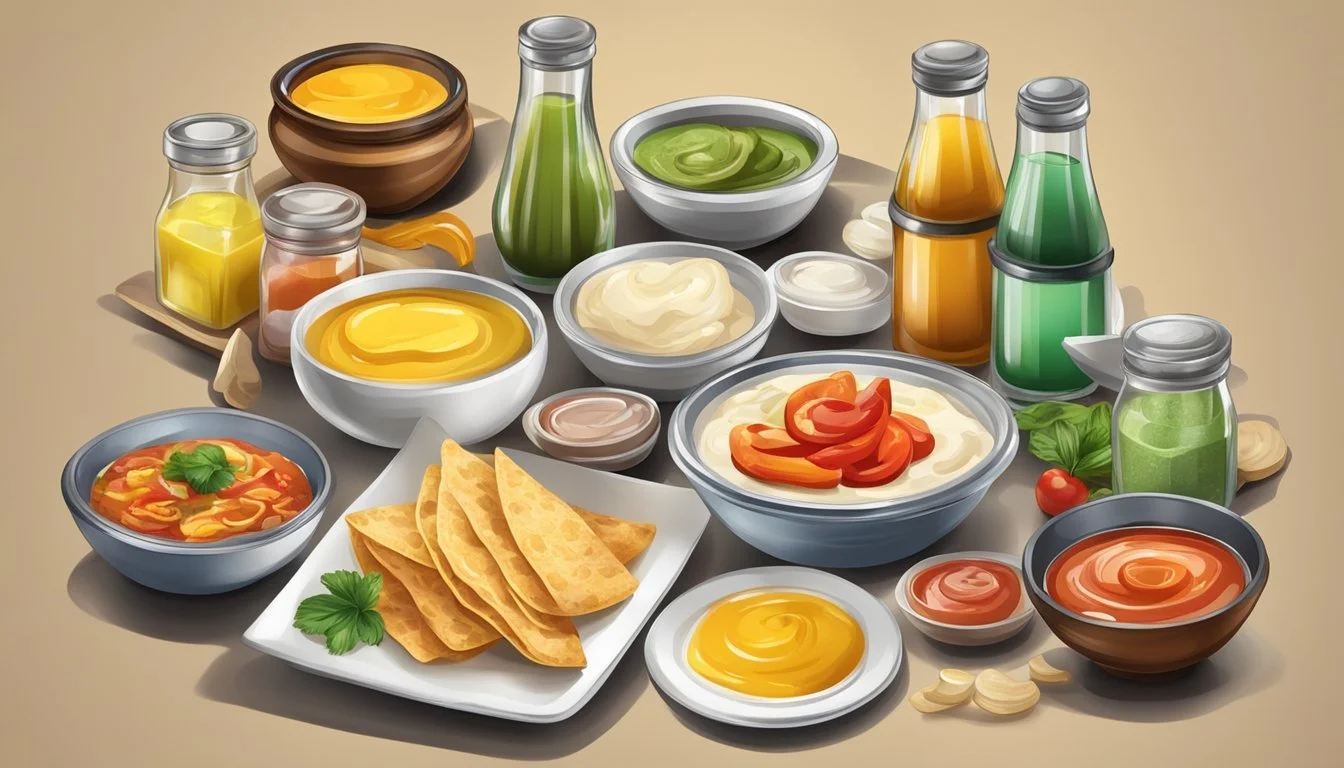Swicy Condiments
Discover the Art of Flavor Enhancement with Innovative Toppings
Condiments are the secret heroes of the culinary world, often turning ordinary meals into extraordinary ones with just a dollop or a drizzle. Swicy, a portmanteau of sweet and spicy, condiments are quickly becoming a favorite among food enthusiasts looking to add both heat and a touch of sweetness to their dishes. This unique balance invigorates taste buds and adds dimension to a wide array of recipes, from the humble burger to a sophisticated gourmet meal.
As diners seek to customize their eating experiences and explore global flavors from the comfort of their kitchens, swicy toppings come to the fore as versatile, bold additions to any meal. These condiments, which range from sriracha mayo to curry ketchup, have the power to elevate a simple dish to a memorable feast. They also reflect a growing trend in the fusion of different culinary traditions, showcasing how diverse ingredients can come together to create new and exciting flavors.
The Art of Seasoning: Understanding Flavors
Seasoning is integral to enhancing the flavor of food. It is not just about adding salt or pepper to a dish but encompasses a broad range of spices and condiments that interact with the taste buds to bring out different sensory experiences.
The Five Basic Tastes
The human palate can detect five primary tastes, each linked to specific taste buds:
Sweet: Often associated with sugar and balance, sweet enhances flavors and can offset bitterness.
Sour: Citrus or vinegar introduces a refreshing tanginess, cutting through rich profiles.
Salty: Integral for highlighting flavors, salt can also preserve food and add texture.
Bitter: Found in dark chocolate or leafy greens, bitter can add complexity to a dish.
Umami: This savory taste, often associated with meats and cheeses, adds depth and richness.
Flavor Combinations
When these tastes are combined skillfully, they create memorable dishes with balanced profiles. Here's how different seasonings contribute to the flavor palette:
Savory: Also known as umami, tastes rich and deep, often from proteins or fermented foods. (What wine goes well with fermented foods?)
Sweet: Provides contrast to savory dishes and can enhance the natural flavors of ingredients.
Spicy: Adds heat and intensity to dishes, catching the attention of taste buds.
Umami: Contributes a full-bodied, complex taste that brings a rich savoriness.
Tangy: Introduces a zesty, fresh note that can lighten heavy or rich dishes (What wine goes well with rich dishes?).
Bold: A strong, prominent flavor that stands out, often achieved with a combination of seasonings.
Depth: The layering of flavors that provides a complex, satisfying taste experience.
Understanding and skillfully managing these flavors are what make a good cook a great one. Seasoning is an art, one that requires knowledge of how different tastes interact and how they can be combined to achieve the desired flavor profile.
Classic Condiments Revisited
Classic condiments serve as the foundation for flavor enhancement in various cuisines. New twists on these staples can transform ordinary meals into extraordinary culinary experiences.
Ketchup: A Tomato-Based Staple
Ketchup, with its tomato base and characteristic sweetness, is a classic condiment found in nearly every household. Though traditionally paired with fries and burgers, innovative chefs are infusing ketchup with additional ingredients like curry or chipotle to add complexity to its flavor profile.
Mustard Varieties and Uses
Mustard, known for its tang and bold flavor, comes in various forms ranging from the classic yellow to the more rich and sophisticated Dijon. One can experiment by mixing mustard with honey or herbs, lending a spicy kick to sandwiches (What wine goes well with sandwiches?) and marinades alike.
Mayonnaise: Creamy Versatility
Mayonnaise stands out for its creamy texture and versatile nature, serving as a base for many other sauces and dressings. Whether it's blending with sriracha to make a spicy mayo or adding garlic for aioli, the possibilities to elevate dishes with mayonnaise are nearly endless.
The World of Hot Sauces
Hot sauces, with their various levels of heat and flavors from chili peppers like jalapeño or habanero, offer a spicy kick to any dish. Well-known varieties such as Sriracha bring a sharp, garlicky heat that can be tempered with sweet elements for a "swicy" twist.
Salsa and Relish: Fresh and Zesty Options
Salsa and relish, often characterized by their fresh and tangy attributes, incorporate diced vegetables or fruits to create vibrant and zesty condiments. They can be simple, like a classic tomato salsa, or more unique, incorporating ingredients such as mango or pineapple for a sweet and spicy note.
Elevating Burgers and Sandwiches
The sophistication of a dish can often be attributed to its condiments. This section explores how unique toppings and textures can transform the ordinary burger or sandwich into a gourmet meal.
Building the Ultimate Burger
To construct an unmatched burger, one begins by considering the classic foundations: quality cheese, crisp lettuce, ripe tomatoes, and perhaps a few strips of smoky bacon. Yet, to truly elevate a burger, one should introduce unexpected elements. A fried egg, with its rich, oozing yolk, can add a luxurious texture. Avocado, on the other hand, provides creamy richness while also imparting a subtle, fresh flavor.
For those seeking to embolden their burger's taste profile, transitioning from traditional to unique toppings is key. Here is a chart of condiment combinations that synergize flavors and textures:
Unique Topping Description Texture Benefit Sriracha Mayo A creamy and spicy blend for a fiery kick. Adds a smooth heat. Guacamole Mashed avocado with lime and tomatoes. Creamy and fresh. Curry Ketchup Ketchup infused with curry spices. Spiced smoothness. Feta Cheese Crumbly and tangy, excellent with olives. Adds a salty crumble.
Creating Gourmet Sandwiches
Sandwiches, versatile by nature, become a canvas for gastronomic creativity when paired with unique condiments. The selection of spread or dressing can impart boldness to an otherwise understated dish. For example, guacamole used as a spread not only complements deli meats but enhances the sandwich with a rich, buttery layer.
Ingredients that contribute to the elevation of a sandwich include:
Burger toppings such as crispy onions or sautéed mushrooms for depth of flavor.
Mild feta cheese mixed into spreads for a tangy twist.
A dollop of tangy chipotle mayo or sweet and savory onion jam for complex flavors.
By wisely choosing each component, even sandwiches enjoyed on ordinary days can feel like a treat for the taste buds without overshadowing the primary ingredients.
Condiments with a Global Twist
Exploring condiments from around the world can transform an ordinary meal into a culinary adventure. Each region brings its own distinct flavors and ingredients, creating exotic and unique accompaniments that can elevate any dish.
Asian Flavors: From Hoisin to Sriracha
Asian cuisine is renowned for its diverse range of flavors, with condiments that add depth and excitement to the palate. Sriracha sauce is a staple Thai condiment that imparts a spicy and garlicky kick, suited for everything from noodles to burgers. Meanwhile, hoisin sauce offers a sweet and savory taste, often used as a glaze in Chinese dishes like Peking duck and stir-fries.
Mediterranean and Middle Eastern Spreads
The flavors of the Mediterranean and Middle East are encapsulated in their rich and healthful spreads. Hummus, a creamy blend of chickpeas, tahini, and olive oil, serves as a nourishing dip or sandwich spread. Pesto, with its vibrant blend of basil, pine nuts, and Parmesan, adds an Italian zest to pastas and breads.
Latin American Salsas and Guacamole
Latin American condiments burst with fresh and zesty flavors. Salsa, a versatile sauce featuring tomatoes, onions, and chilies, ranges from mild to fiery and pairs well with a multitude of dishes. Guacamole, a blend of mashed avocado, lime, and cilantro, is an essential topping for tacos and a delightful dip on its own.
European Influences: Mustard and Aioli
European condiments such as mustard and aioli offer bold flavors. Mustard, available in forms from Dijon to whole grain, provides a tangy and sometimes spicy touch to sandwiches and vinaigrettes. Aioli, a garlic-infused mayonnaise of Provençal origin, brings a creamy richness to everything from seafood to roasted vegetables.
African and Indian Heat: Harissa and Chutneys
African and Indian cuisines offer condiments that combine heat and complexity. Harissa, a North African chili paste, delivers a smoky spice to meats and stews. Indian chutneys, made with a variety of fruits, herbs, and spices, range from sweet to piquant, complementing both savory snacks and main dishes with their bold flavors.
Innovative Homemade Creations
The modern culinary enthusiast's kitchen brims with creativity, transforming ordinary meals into extraordinary experiences with homemade condiments. These unique creations are not only a testament to personal taste but also offer healthier alternatives to store-bought versions.
Crafting Unique Sauces at Home
One can begin their journey of sauce-making by experimenting with simple combinations. A fusion of sriracha and mayonnaise yields a creamy yet spicy condiment, perfect for adding a fiery kick to burgers. Alternatively, blending avocado, lime juice, and diced tomatoes can result in a fresh and flavorful guacamole. Home chefs can elevate their ketchup by incorporating a hint of curry powder, creating a unique condiment that brings a vibrant twist to traditional flavors.
Making Homemade Condiments
Homemade condiments allow for full control over flavor and quality. For instance, mastering the balance of sweet and tangy in Honey Dijon Mustard can make for a versatile topping that enhances salads and sandwiches alike. Enthusiasts who enjoy a touch of heat might venture into crafting Louisiana Hot Sauce, where the zest of Cajun spices meets the thrill of homemade culinary adventure.
Healthy Alternatives to Store-Bought
Store-bought condiments often come with added preservatives and sugars, but homemade alternatives grant a healthier route without sacrificing taste. Using Greek yogurt as a base for dressings or dips, offering both a creamy texture and a protein boost, is a nutritious twist on more traditional, heavier options. Condiments like chili crisp can incorporate natural ingredients like chili flakes and oil, providing a cleaner label and a customizable heat level for any dish.
Pairings and Applications
The success of a dish can often hinge on the right condiment pairing, where creativity meets flavor to transform meals into memorable dining experiences. This section explores the best swicy condiment applications for meat-based and vegetarian dishes (What wine goes well with vegetarian dishes?), as well as sweet toppings for desserts.
Best Combinations for Meat and Grilling
When it comes to grilling meats, a swicy condiment that combines sweetness with a spicy kick can elevate traditional barbecue fare.
Burgers: A tangy, sweet barbecue sauce intermingled with a kick of chipotle can add layers of flavor to a juicy grilled burger.
Steak: A glaze of honey and a bold hot sauce can enhance the savory taste of grilled steak, balancing the richness of the meat with sweetness and heat.
Vegetarian Dishes and Condiment Pairings
Vegetarian dishes benefit greatly from the depth that swicy condiments offer, providing a powerful flavor boost to plant-based proteins.
Pasta dishes: Cheesy-flavored nutritional yeast paired with a hint of chili oil can add a comforting zest to vegan pastas.
Tofu scrambles: Sriracha, offering both heat and a touch of sugar, can give a simple tofu scramble an appetizing complexity.
Sweet Condiments with Desserts
Swicy condiments aren't limited to savory meals—they can also add an exciting twist to desserts.
Fruit-based desserts: (What wine goes well with fruit-based desserts?) A drizzle of chili-infused syrup can complement the sweetness of fruit-based desserts, creating a harmonious blend of spicy and sweet.
Chocolate desserts (What wine goes well with chocolate desserts?): A pinch of cayenne pepper mixed into a chocolate syrup provides a surprising but pleasant kick that enhances the rich cocoa flavors.
The Science of Taste: How Condiments Affect Flavor Profiles
When one adds condiments to a dish, they are intricately altering the food's flavor profile. These toppings engage the taste buds in complex ways, enhancing, masking, or balancing various elements of a dish's inherent taste.
Condiments like swicy—a blend of sweet and spicy—play with these profiles masterfully. For instance, sugar is well-known to offset heat, providing a harmonious balance that appeases the palate. Consider the interplay of flavors in the following table:
Taste Element Condiment Action Resulting Sensation Spicy Adds heat Excites taste buds Sweet Mitigates spiciness Soothes and balances
The human tongue recognizes five primary tastes: sweet, salty, bitter, sour, and savory (umami). Taste receptors detect these flavors and send signals directly to the brain, creating the perception of taste. When swicy condiments enter the mix, they influence these signals, sometimes pairing unexpectedly well with elements like umami found in fermented foods.
Indeed, the science of taste and the flavor palate is nuanced, consisting of chemosensory processes that impact not just flavor but the overall eating experience. Condiments serve not only as a finishing touch but as catalysts that define or redefine a meal's flavor profile, ensuring each bite is as memorable as the last.
Understanding this can elevate one's culinary artistry, utilizing condiments not just as add-ons but as integral components that can turn a simple meal into a symphony of flavors.
Culinary Trends: Beyond the Ordinary
The landscape of culinary innovation is constantly shifting, introducing extraordinary trends that revolutionize the way we think about and enjoy food.
Emerging Trends: What's Next in Condiments
Innovation in the condiment space has always been a reflection of evolving taste preferences and cultural integration. It thrives on the exploration of unconventional flavor pairings that challenge traditional palates. The latest trend illuminating the food scene is the rise of 'swicy' condiments—a blend of sweet and spicy elements creating a symphony of flavors that are anything but ordinary.
Sweet Meets Spice: A dramatic increase in sweet and spicy pairings on menus signifies a departure from conventional tastes. Hot honey is leading the charge as a versatile topping, expected to surpass other flavors in popularity due to its ability to complement a diverse range of dishes.
The Swicy Movement: A culinary trend that marries the heat of spices with the subtlety of sweetness challenges diners to rethink their flavor expectations. On social media platforms like TikTok, the swicy trend emphasizes this balance, creating a heightened sensory experience.
Experts in the culinary field observe these emerging trends as evidence of a broader shift towards more adventurous eating. Consumers aren't just satisfied with the familiar; they're actively seeking out new and extraordinary combinations that offer a novel taste experience. Condiments serve as an accessible avenue for this exploration, allowing for small but significant variations in everyday meals.
Practical Tips and Storage
When incorporating swicy condiments into your cuisine, it is essential to consider proper storage and safety to maintain their quality and flavor profile.
Proper Condiment Storage
For optimal preservation, one should store swicy condiments in clean, sterilized containers to prevent bacterial growth and spoilage. They should maintain these containers in the refrigerator, where temperatures are stable and conducive to prolonging the condiments' freshness.
Condiment Shelf Life and Safety
The shelf life of these condiments varies and is dependent on their individual ingredients. Homemade swicy condiments typically last for up to two weeks when stored properly. Commercial condiments may have preservatives that extend their shelf life further. It is crucial to label and date them upon storage and to regularly check for signs of spoilage such as off odors, colors, or textures.
Tips for Using and Storing Specialty Toppings
When using specialty swicy condiments, they should only take what's needed for immediate use to avoid contamination. Using clean utensils each time can help avoid introducing bacteria into the condiment.
Organization: Arrange condiments in the refrigerator door or on a dedicated shelf in order of their expiration dates to ensure older items are used first, preventing waste.
Temperature: Keep specialty toppings refrigerated at or below 40°F to ensure safety.
Quantity: Prepare them in smaller batches if they are homemade, to ensure they are consumed while fresh.
By following these practical guidelines, one can ensure that swicy condiments are safely stored and retain their intended flavor quality.
Final Thoughts: Expanding Your Culinary Toolbox
In the quest to elevate one's culinary creations, the adoption of swicy condiments can play a transformative role. The juxtaposition of sweet and spicy elements within a single condiment offers layers of flavor, providing an avenue for chefs and food enthusiasts to express their creativity and explore new combinations.
Incorporating Swicy Condiments:
Explore regional markets for unique ingredients.
Experiment with balance in sweet and spicy flavors.
Start with modest amounts, adjusting to personal taste.
Expanding a culinary toolbox doesn't require a complete overhaul of techniques or resources; rather, it invites one to weave swicy elements into their existing repertoire. Chefs can start with familiar bases such as mayonnaise or ketchup and introduce swicy components incrementally.
Creating Homemade Swicy Toppings:
Sriracha Mayo:
Blend mayonnaise with sriracha sauce for a creamy kick.
Curry Ketchup:
Infuse ketchup with a hint of curry powder.
Embracing these flavors not only broadens one's culinary horizon but also elevates the dining experience. Swicy condiments are versatile, able to complement a range of dishes from burgers to enchiladas, and can be as simple or complex as the chef desires.
Chefs should note the cultural roots of these flavors, respecting the traditional methods and histories behind them. By infusing meals with swicy condiments, they imbue their dishes with both a sense of adventure and homage to culinary diversity. Through thoughtful application, any cook can enrich their meals and delight the palates of their diners.










